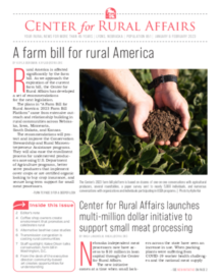Editor's Note
The Center for Rural Affairs is approaching a major milestone. This year, on Sept. 5, we celebrate 50 years.
In 1973, we were founded by rural Nebraskans concerned about the loss of economic opportunity in agriculture and the decline of rural communities. Fifty years later, we remain focused on these issues plus more that affect rural people across the country.
The workload has expanded and will continue evolving as communities are faced with new opportunities and challenges. Our staff has multiplied—we now have about 50 full-time staff in four states. Our budget has increased—in 1973, who could’ve dreamed of a $10 million grant like what is featured on the front page of our newsletter?
I bet you have a story of how you connected with us. How many years have you received our newsletter? Did you work at the Center? Were you a part of our work in the 1980s? ‘90s?
Throughout this next year, we’ll be looking back at our last 50 years, studying our present work, and determining what the next 50 years of the Center looks like.
We want to hear from you. Send me an email at [email protected]. Tell us your Center story. Let us know what topics you are most interested in and what you see in our future. I look forward to reading your stories and may even feature them in a future newsletter story or blog (with your permission, of course).
In this issue
-
A farm bill for rural America - Rural America is affected significantly by the farm bill. As we approach the expiration of the current farm bill, the Center for Rural Affairs has developed a set of recommendations for the next legislation.
-
Center for Rural Affairs launches multi-million dollar initiative to support small meat processing - Nebraska independent meat processors now have access to $10 million in loan capital through the Center for Rural Affairs.
-
Coffee shop owners create environment that promotes and celebrates rural - Take the risk. For Rachael Barlow and Heather Veik, those are words to live by. Although they weren’t sure what it might turn into, these two good friends dreamed of doing something unique together. And, while all sorts of ideas, projects, and plans crossed their minds, one in particular kept coming back to them.
-
Alternative beehive case studies - The standard hive in Nebraska is a traditional Langstroth. The Center for Rural
Affairs conducted a research project with outside beekeepers, designed to compare and highlight four alternative hive structures: Nuc, Shallow, Top Bar, and Long Langstroth. Each beekeeper was required to keep an alternative hive, as well as two traditional Langstroth hives to use as controls. -
Transmission congestion is costing rural communities - Wind farms pay tax revenue to the communities that host them based on how much energy they produce. In some cases, the wind industry is the largest source of property tax to a county or township. However, there is not enough transmission infrastructure to support the amount of energy generated, causing grid congestion.
-
Staff spotlight: Kalee Olson talks conservation, farm bill in Washington, D.C. - As part of the Center’s grassroots work with producers in Nebraska, Iowa, South Dakota, Kansas, and Minnesota, Kalee met with U.S. Sen. Deb Fischer and staff of U.S. Reps. Don Bacon and Mike Flood about the Conservation Stewardship Program (CSP).
-
From the desk of the executive director: community-based art creates opportunities for understanding - Community-based and socially engaged art can help to build community, deepen understanding, and encourage empathy.


